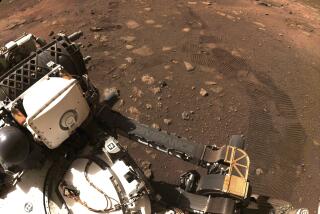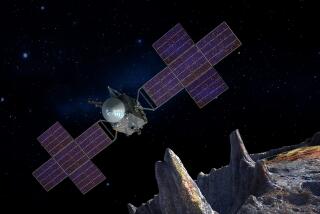NASA hopes Curiosity landing site is a Grand Canyon of Mars
In the spring of 1869, a geology professor who had lost an arm to a musket ball at the Battle of Shiloh led a tortuous journey down a canyon that had been etched into stone, a mile deep, by the unremitting force of the Colorado River.
There, in what would become known as the Grand Canyon, John Wesley Powell found a diary of the Earth’s adolescence — layer upon layer of varied, exposed rock spanning 2 billion years. If there were a Bible of geology, Powell wrote, this would be the Book of Revelation.
On Sunday, 143 years later, scientists will attempt to retrace that journey — on Mars.
PHOTOS: History of Mars exploration
The NASA robot dubbed Curiosity is scheduled to land Sunday night at the foot of a mountain that scientists believe contains a similar record of Mars’ past. In the next two years, Curiosity is to painstakingly climb the mountain’s foothills — probing layers of exposed rock and then sending home what scientists hope will be the most compelling evidence yet that we are not alone in the universe.
“Are we really a 1-in-a-gazillion accident?” asked Matthew P. Golombek, a senior research scientist at the Jet Propulsion Laboratory in La Cañada Flintridge. “That’s almost a theological question. And we need to run it down.”
Curiosity, the largest and most advanced machine ever sent to another planet, is expected to land in a feature known as Gale Crater. About the size of Riverside County, the crater was formed more than 3 billion years ago when a meteor slammed into Mars just south of its equator.
PHOTOS: Preparing for Martian landing
That was pretty typical. Mars has been pummeled by meteors over the years, including more than 40,000 that created impact craters at least three miles wide. What was unusual, and what raised the eyebrows of scientists selecting a landing site, was Mt. Sharp, a massive mountain at the center of Gale Crater.
Named in honor of the late Robert Phillip Sharp, a groundbreaking Caltech geologist who had served as a mentor to some of the JPL scientists who are managing the mission for NASA, Mt. Sharp rises three miles from the floor of the crater.
Most craters have a mound of some sort in the middle, caused by the same physical principles captured in ultra-slow-motion photographs, when a droplet of milk pops back up after a larger drop falls through the surface.
GRAPHIC: Curiosity, from liftoff to landing
But this was no mound. Inside Gale Crater was a full-fledged mountain, taller than any in the Lower 48 states, so high that its peak rose above some portions of the rim of the surrounding crater. It was “too big for normal,” said Ashwin R. Vasavada, a deputy project scientist at JPL who is helping oversee the Mars mission.
Despite the intrigue, in the years leading up to the Mars mission, Gale Crater was not the first choice of the scientific community. Its selection required a little help from its friends — namely, the 11th-hour delivery of a surprising batch of data from a satellite passing overhead.
The choice of a landing site was arguably the second-most important decision of the mission, after the decision to send the robot to Mars in the first place. “What you study with a landed mission sets the tone for where our science on Mars goes from here,” said Golombek, who oversaw the selection of Curiosity’s landing site. “It’s critical.”
Five years ago, JPL began soliciting the input of scores of Mars-watchers, who made impassioned arguments at a series of workshops for what might be learned at their favored landing site.
The idea was to start with a list of potential sites, and then at the workshops cull them to a few that were relatively safe and offered the most scientific bang for the mission’s $2.5-billion buck. But there was so much input and enthusiasm that the list of candidate sites grew after the workshops began. Fifteen more were added, bringing the total to 60.
Eventually, the list had to shrink. Engineers forced the elimination of numerous sites when they decided that Curiosity would need to land closer to the equator than they initially hoped. Mars, despite its immense scientific allure, presents a notoriously difficult thermal environment for space exploration, with temperature swings of more than 100 degrees routine in a single day. Temperatures are more consistent at Mars’ equator than at its poles — and some of the proposed sites had to be eliminated because they were too far from the equator.
As the list began to get reduced, Gale Crater was still hanging around. But, in the eyes of many scientists, it was not the front-runner. That honor would have probably gone to another crater, a site known as Eberswalde.
There, scientists had discovered the hardened, dry remnants of what appeared to be an ancient delta — a “fan” where a powerful river splashed into a standing body of water, similar to the muddy wash where the Mississippi empties into the Gulf of Mexico near New Orleans.
“There was a river, and there was a lake. That’s pretty awesome,” Vasavada said.
It was firm proof, scientists believed, that water once flowed on Mars — a critical notion, because every environment that contains water, at least on Earth, sustains microbial life.
But scientists already knew that water once existed on the surface of Mars. Older missions had offered plenty of suggestions, and the twin rovers NASA sent to Mars in 2003, Spirit and Opportunity, had proved it in spectacular and definitive fashion.
The new rover’s mission was more complex: a search for all of the basic ingredients of life, particularly carbon-carrying organic molecules.
What’s more, there were percolating questions about what the delta might prove. There was a risk that the delta was not a record of Mars’ history, but a “one-trick pony,” Vasavada said, an aberration forged in a relatively short period of time, at least by geologic standards.
As discussions continued, NASA’s Mars Reconnaissance Orbiter, which launched in 2005, was quietly circling the planet. The MRO, as it is known in space science parlance, was designed to pave the way for landed missions on Mars by mapping the planet’s surface and conducting a higher-fidelity investigation of Mars’ weather and environment than had ever been accomplished.
Starting a couple of years ago, the MRO began sending home a data dump about the landing site finalists. The data made it clear that all of the finalists contained vast scientific possibilities, but none more than Gale Crater and its mountain.
The MRO was equipped with lasers that could peer into the planet’s surface and detect the presence of minerals.
The mountain, it turned out, was once not a mountain at all. It was part of a giant, layered plateau, which was then eroded — perhaps by wind, perhaps by water — into a cone.
On its slopes, the MRO found distinct layers of rock, like those John Wesley Powell found in the Grand Canyon.
The lowest tier of the mountain was built of clay, a remnant of what appear to have been Mars’ water years, topped with a layer of mineral-rich sulfates created when the water disappeared, topped with layers of sand and dust.
Here could be a record of Mars’ environmental history — of two planetary-scale geologic phenomena, the first when water appears to have covered Mars with sediment, the second when Mars dried up and the sediment was stripped away. Last summer, NASA made it official: Curiosity would land in Gale Crater and, from there, would head for the mountain.
“Gale was a racehorse that was in the back of the pack and then jumped ahead,” Vasavada said. “You want to look at piles of stuff — that’s where history is recorded. The rocks at the bottom are old. The rocks above are younger. And some amount of time is recorded for us in between. We think Gale has many stories to tell. We’re going to ask it what happened.”







